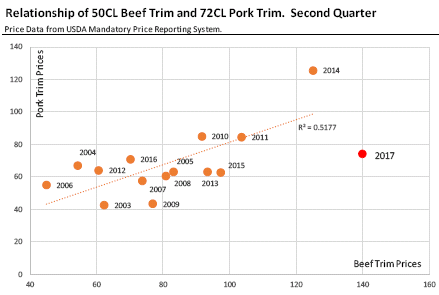



CME: Short Term Situation in Pork Complex Positive
US - Despite the down day on Thursday (1 June) and the weak open the next morning, the short term situation in the pork complex is positive, reports Steiner Consulting Group, DLR Division, Inc.The pork cutout has rebounded from April levels and it is slowly inching higher, which is usually the case this time of year. The robust cutout values have allowed packers to bid more aggressively for hogs.
Despite higher prices paid for hogs (1 day cash index is now around $77/cwt), gross margins remain quite robust and actually running higher than the levels we saw during this time in 2014. That’s quite telling.
Retail demand should be good with both Father’s Day and 4 July ahead of us and retailers looking to provide consumers with ample grilling options. Given the runup in beef prices, pork is by far the economical alternative at this time.
Our estimate for the packer gross margin currently stands at around $49/head. This assumes a cutout for this week at somewhere around $91.5/cwt (last night it was 91.44) and net hog price at around $77/cwt.

The drop credit at around $19/cwt is a little lower than it was during this week last year but still substantially better than in some previous years. One note on the drop credit: we use the LMIC calculations rather than the reported USDA number.
Current strong margins should incentivize pork packers to maintain full slaughter schedules. In the last three full slaughter days, daily kill has averaged 439k head.
Hog carcass weights have been trending lower and they are now well under last year’s levels (see chart). Based on the Mandatory Price Reporting data, the average weight of barrows and gilts for producer owned hogs was 210.9 pounds, down 0.7 per cent from a year ago.

The average weight of packer owned hogs has been declining at a faster pace and it is currently down 1.8 per cent from last year. This latter point is important since packer owned hogs are a significant portion of the overall hog supply coming to market.
For the week ending 27 May, packer owned hogs made up 29.75 per cent of all hogs slaughtered. Why have packer hog weights declined so much in the last few weeks? We do not know of any operational issues (maybe our readers do) and our best guess is that this is a reflection of the good margins and packers pulling on their own supply first rather than raising bids to secure hogs from producers.
But as hog supplies become more current and pork demand holds up, eventually this should leader to higher hog values and futures currently maintain a premium over the cash market reflecting this expectation.
Other positives for pork we can point to: The latest pork export data was quite strong, with weekly exports over 24,000 MT and exports to China over 3000 MT. New export sales were lower this week, which should indicate some slowdown down the road but, for the moment pork exports are on track to increase by double digits compared to May 2016 levels.
Record high prices for beef fat trimmings should encourage hot dog manufaturers and other processors to maximize the amount of pork trim in their formulations. The relationship between beef 50CL and 72CL pork is not perfect but generally they move together (see chart).

Current deviation from the trend line is even bigger than what we saw in 2014 and indicates that pork trim has more upside risk given the high price of 50s. Finally, seasonal demand and tight cold storage stocks are positive for pork belly prices and the overall cutout.








